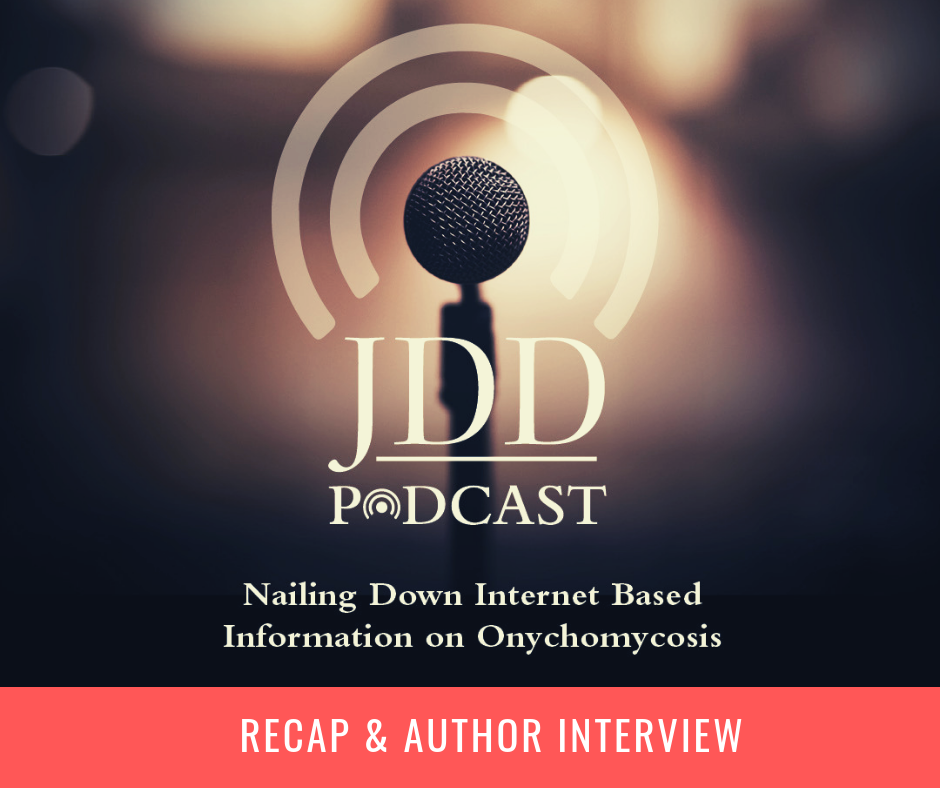Podcast host Dr. Adam Friedman sat down with Dr. Shari Lipner, associate professor of dermatology at New York-Presbyterian Hospital/Weill Cornell Medical Center and international nail expert extraordinaire, to discuss the accuracy and quality of internet based information on Onychomycosis.
Dr. Aaron Fong, PGY-3 dermatology resident at George Washington University School of Medicine and Health Sciences, shares key takeaways from Dr. Lipner’s JDD podcast titled “Nailing Down Internet Based Information on Onychomycosis”.
On Dr. Lipner’s JDD study titled “Evaluation of Onychomycosis Information on the Internet”
Dr. Lipner was inspired to conduct this study because many of her patients who have onychomycosis begin their clinic visit with misinformation. She wanted to assess what online information is available to patients for this condition.
Online resources were found using 5 popular search engines (Google, Yahoo, Bing, AOL, and Ask) with the terms “onychomycosis” or “nail fungus.”
Websites were graded using a predetermined scoring system, which assessed for accountability, quality of medical information, readability, display, support features, and transparency/disclosures.
The mean overall score of these websites was only 20 out of a possible 43 points, indicating that there is a lot of misinformation circulating on the internet.
Only one third of sites met an acceptable reading level of 7th grade or lower. A summary of the rest of her data can be found in a table in her original article.
Dr. Lipner recommends spending extra time educating patients due to the amount of misinformation available for onychomycosis. She states that we should not assume patients have already Googled the condition and have good information on subject. She states that handouts can be useful to help patients remember what was said at the patient visit.
On treating onychomycosis
Dr. Lipner emphasizes the importance of a thorough history for the diagnosis of onychomycosis. Duration, symptoms such as pain or trouble walking, personal or family history of tinea pedis or onychomycosis, and habits/ hobbies such as swimming or walking bare foot all are important to help with this diagnosis.
Distal lateral subungual onychomycosis most common subtype. This presents with onycholysis and subungual hyperkeratosis.
Dermoscopy can be helpful. The most common pattern seen with onychomycosis is a fringed proximal border in area of onycholysis.
Clinicians should always do diagnostic testing prior to treatment of onychomycosis. A simple physical exam or “eyeballing” is not enough! Key diagnoses such as squamous cell carcinoma or amelanotic melanoma could be missed.
It is common to have both tinea pedis and onychomycosis. However, tinea pedis can be subclinical where patients do not have scaling. This enforces the importance of diagnostic testing.
Since Dr. Lipner usually sees complex onychomycosis patients, her typical diagnostic approach is to do nail clipping for PAS, fungal culture, and PCR. She suggests other clinicians to at least perform a KOH, but mentions PAS has great sensitivity and is simple to perform.
Dr. Lipner is moving away from routine lab monitoring when using oral terbinafine. In her practice, she has rarely seen any symptoms or abnormalities with terbinafine. She references a recent article from JAMA Dermatology that showed that lab abnormalities with terbinafine and griseofulvin were extremely rare.
In her practice, Dr. Lipner takes baseline labs in healthy adults and children when starting terbinafine and does not do further lab work if patients are asymptomatic.
While terbinafine is most commonly used and most effective, there is some utility on using topical therapy. Topical treatments can be helpful for mild disease with up to three nails involved or in patients with contraindications to oral therapy
Off-label use fluconazole with weekly pulse dosing can be helpful if patient has already failed terbinafine or if culture shows both dermatophyte and yeast. Dr. Lipner usually does a 6 month course for fingernails and 12 months for toenails.
Another off-label treatment option is a microclipper device, which drills tiny holes in nail plate, followed by topical terbinafine.
A follow up visit after completion of therapy can be very helpful to reinforce patient education and discuss the risk of recurrence.
Topical antifungals after completing oral therapy can help lower the recurrence rate.
Make sure to tune in and listen to the podcast here.
Words From The Investigator
I also had the chance to ask Dr. Lipner a few questions on her advice to residents and the one book she thinks everyone should read:
What is the most effective way clinicians can educate patients on onychomycosis?
Since the reliability and accuracy of onychomycosis information on the internet varies greatly, dermatologists should educate patients in the office, face to face, about this important topic. Patient handouts are also extremely helpful.
What is one piece of advice for current residents and young dermatologists?
Young dermatologists should always perform a laboratory confirmation before treating patients for onychomycosis. Performing KOH with microscopy, fungal culture, histopathology on nail clippings, or PCR before treating for onychomycosis, avoids treatment failures, missed diagnoses, and unwanted side effects.
What is one book everyone should read?
Scher and Daniel’s Nails: Diagnosis, Surgery and Therapy, 4th edition, is a comprehensive textbook on nail disease and there are several chapters dedicated to diagnosis and treatment of onychomycosis.
Did you enjoy this JDD podcast recap? Find more here.

